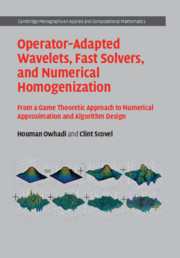 Operator-Adapted Wavelets, Fast Solvers, and Numerical Homogenization
Operator-Adapted Wavelets, Fast Solvers, and Numerical Homogenization Book contents
- Frontmatter
- Dedication
- Contents
- Preface
- Acknowledgements
- Reading Guide
- 1 Introduction
- Part I The Sobolev Space Setting
- Part II The Game Theoretic Approach
- Part III The Banach Space Setting
- 11 Banach Space Basics
- 12 Optimal Recovery Splines
- 13 Gamblets
- 14 Bounded Condition Numbers
- 15 Exponential Decay
- 16 Fast Gamblet Transform
- Part IV Game Theoretic Approach on Banach Spaces
- Part V Applications, Developments, and Open Problems
- Part VI Appendix
- Bibliography
- Algorithms
- Glossary
- Nomenclature
- Index
- Identities
14 - Bounded Condition Numbers
from Part III - The Banach Space Setting
Published online by Cambridge University Press: 10 October 2019
- Frontmatter
- Dedication
- Contents
- Preface
- Acknowledgements
- Reading Guide
- 1 Introduction
- Part I The Sobolev Space Setting
- Part II The Game Theoretic Approach
- Part III The Banach Space Setting
- 11 Banach Space Basics
- 12 Optimal Recovery Splines
- 13 Gamblets
- 14 Bounded Condition Numbers
- 15 Exponential Decay
- 16 Fast Gamblet Transform
- Part IV Game Theoretic Approach on Banach Spaces
- Part V Applications, Developments, and Open Problems
- Part VI Appendix
- Bibliography
- Algorithms
- Glossary
- Nomenclature
- Index
- Identities
Summary
This chapter bounds the condition numbers of thestiffness matrix of operator-adapted wavelets within each subband (scale). These resulting bounds are characterized through weak alignment conditions between measurement functions and eigensubspaces of the underlying operator. In Sobolev spaces, these alignment conditions translate into approximate error estimates associated with variational splines andscattered data approximation. These estimates are established for the three primary examples, subsampled Diracs, Haar prewavelets, and local polynomials,of hierarchies of measurement functions in Sobolev spaces.
Keywords
Information
- Type
- Chapter
- Information
- Operator-Adapted Wavelets, Fast Solvers, and Numerical HomogenizationFrom a Game Theoretic Approach to Numerical Approximation and Algorithm Design, pp. 195 - 251Publisher: Cambridge University PressPrint publication year: 2019